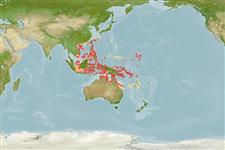Environment: milieu / Zona climática / intervalo de profundidade / distribution range
Ecologia
marinhas associadas(os) a recifes; intervalo de profundidade 15 - 30 m (Ref. 48637). Tropical; 30°N - 23°S, 105°E - 171°E
Western Pacific: Ryukyu Islands to Australia. Occurrence of this species in the Indian Ocean is doubtful.
Tamanho / Peso / Idade
Maturidade: Lm ? range ? - ? cm
Max length : 45.0 cm TL macho/indeterminado; (Ref. 9710)
Espinhos dorsais (total) : 5 - 6; Raios dorsais (total) : 34 - 37; Espinhos anais: 3; Raios anais : 24 - 28. Juveniles are dark brown to black with a brilliant crimson margin around the entire fish (Ref. 1602). Adults dull silver with short fins (Ref. 1602). Body orbicular and strongly compressed, its depth more than twice length of head and 0.9 to 1.3 times in SL. Head length 2.9 to 3.8 times in SL. Large adults (above 35 cm SL) with protruding snout, the front head profile distinctly concave. Interorbital width 34 to 42% head length. Jaws with bands of slender, flattened, tricuspid teeth, the middle cusp about twice length of lateral cusps. Vomer with teeth, but none on palatines. Three or 4 pores on each side of lower jaw. Preopercle smooth. Opercle without spines (Ref 43039).
Body shape (shape guide): short and / or deep; Cross section: compressed.
Adults are generally solitary and found under overhangs of steep outer reef slopes to a depth of at least 20 m. Juveniles are encountered in mangroves and inner sheltered reefs where they seek shelter in caves or under ledges. Feeds on algae as well as jellyfish and other gelatinous zooplankton (Ref. 6113). Sometimes adults are seen in large schools travelling over open substrate (Ref. 48637).
Ciclo de vida ou comportamento de acasalamento
Maturidade | Reprodução | Desova | Ovos | Fecundidade | Larvas
Myers, R.F., 1991. Micronesian reef fishes. Second Ed. Coral Graphics, Barrigada, Guam. 298 p. (Ref. 1602)
Status na Lista Vermelha da UICN (Ref. 130435: Version 2025-1)
Ameaça para os humanos
Harmless
Uso pelos humanos
Pescarias: pouco comercial; Aquário: Espécies comerciais
Ferramentas
Relatórios especiais
Baixar XML
Fontes da internet
Estimates based on models
Preferred temperature (Ref.
123201): 25 - 29, mean 27.9 °C (based on 152 cells).
Índice de diversidade filogenética (Ref.
82804): PD
50 = 0.5313 [Uniqueness, from 0.5 = low to 2.0 = high].
Bayesian length-weight: a=0.02692 (0.01132 - 0.06402), b=2.94 (2.74 - 3.14), in cm total length, based on LWR estimates for this (Sub)family-body shape (Ref.
93245).
Nível Trófico (Ref.
69278): 3.7 ±0.29 se; based on food items.
Resiliência (Ref.
120179): médio(a), tempo mínimo de duplicação da população 1,4 - 4,4 anos (Preliminary K or Fecundity.).
Fishing Vulnerability (Ref.
59153): Low to moderate vulnerability (35 of 100).
🛈
Nutrients (Ref.
124155): Calcium = 44.5 [22.5, 68.1] mg/100g; Iron = 0.587 [0.356, 0.925] mg/100g; Protein = 18.7 [17.5, 19.8] %; Omega3 = 0.0998 [, ] g/100g; Selenium = 30.5 [16.3, 56.4] μg/100g; VitaminA = 81.4 [24.6, 257.6] μg/100g; Zinc = 0.896 [0.611, 1.273] mg/100g (wet weight);
